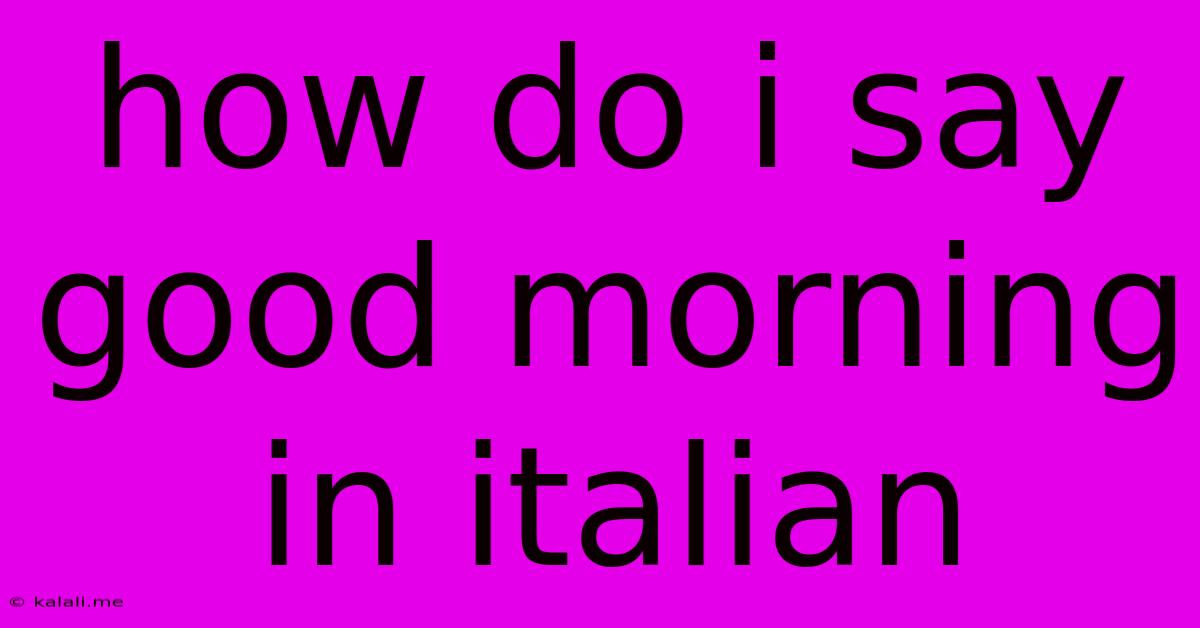How Do I Say Good Morning In Italian
Kalali
May 25, 2025 · 2 min read

Table of Contents
How Do I Say Good Morning in Italian? A Comprehensive Guide
So, you're looking to expand your Italian vocabulary and learn how to greet someone in the morning? You've come to the right place! This guide will not only teach you how to say "good morning" in Italian but also explore different nuances and situations where you might use these greetings. Knowing how to greet someone properly can significantly enhance your interactions and leave a positive impression.
The Most Common Way to Say Good Morning:
The most straightforward and universally accepted way to say "good morning" in Italian is "Buongiorno" (pronounced bwohn-JOR-noh). This greeting is suitable for any time of the morning, from early sunrise to late morning. It's a versatile and polite way to start a conversation, regardless of whether you're speaking to a friend, colleague, or stranger.
Variations and Nuances:
While "Buongiorno" covers most situations, Italian, like any language, offers variations depending on context and formality. Let's explore some of them:
-
Formal settings: "Buongiorno" remains perfectly acceptable in formal situations like business meetings or interactions with elders. You don't need to change your greeting based on formality.
-
Informal settings: With close friends and family, "Buongiorno" remains perfectly appropriate. There aren't really any more informal equivalents.
-
Time of day: While "Buongiorno" works throughout the morning, it's generally used until around midday (12 pm). After that, you'd switch to "Buon pomeriggio" (good afternoon).
-
Regional variations: While "Buongiorno" is universally understood, subtle regional variations in pronunciation might exist. However, these are minor and won't affect comprehension.
Beyond the Basics: Adding Politeness
Italian culture places a strong emphasis on politeness. To further enhance your greeting, you can add phrases like:
-
"Buongiorno a tutti!" (Good morning, everyone!) - Use this when greeting a group of people.
-
"Buongiorno, signore/signora/signorina." (Good morning, sir/madam/miss) - Adding these titles shows respect, particularly in formal situations. "Signore" is for men, "Signora" for married women, and "Signorina" for unmarried women.
Putting it all together: Example Sentences
Here are some examples of how to use "Buongiorno" in different contexts:
-
Meeting a colleague: "Buongiorno, Marco! Come stai?" (Good morning, Marco! How are you?)
-
Greeting a shop assistant: "Buongiorno, vorrei comprare questo." (Good morning, I would like to buy this.)
-
Saying good morning to your family: "Buongiorno, amore mio!" (Good morning, my love!)
Mastering the Pronunciation:
Accurate pronunciation is crucial for effective communication. Listen to audio recordings of native speakers to familiarize yourself with the correct intonation and stress. Many online dictionaries and language learning apps offer audio pronunciations. Pay attention to the stress on the second syllable ("JOR").
Conclusion:
Learning how to say "good morning" in Italian is a simple yet significant step towards improving your language skills. By mastering "Buongiorno" and understanding its nuances, you'll be well-equipped to engage in polite and effective communication with Italian speakers. So, go ahead and start using it! Buongiorno!
Latest Posts
Latest Posts
-
Is An Upside Down Cross Sign Bad
May 26, 2025
-
How Do You Say Dad In Japanese
May 26, 2025
-
Error Stat Of Oracle Log Failed Permission Denied
May 26, 2025
-
How To Stop Dogs From Digging
May 26, 2025
-
How Often Should I Replace My Furnace Filter
May 26, 2025
Related Post
Thank you for visiting our website which covers about How Do I Say Good Morning In Italian . We hope the information provided has been useful to you. Feel free to contact us if you have any questions or need further assistance. See you next time and don't miss to bookmark.